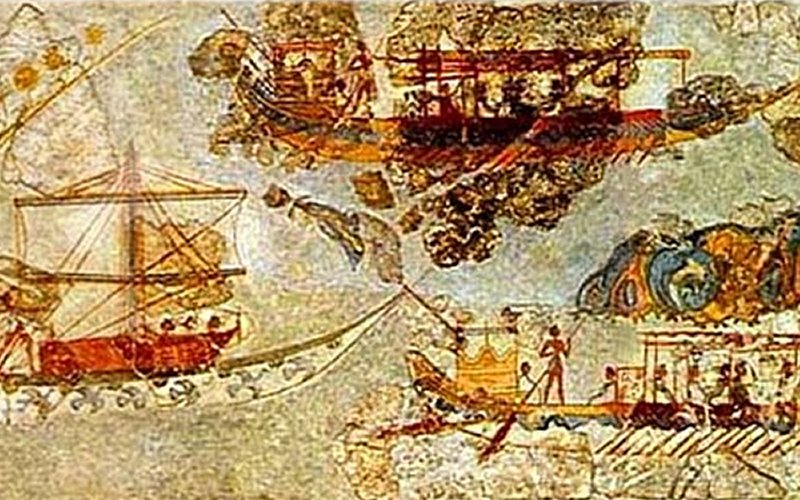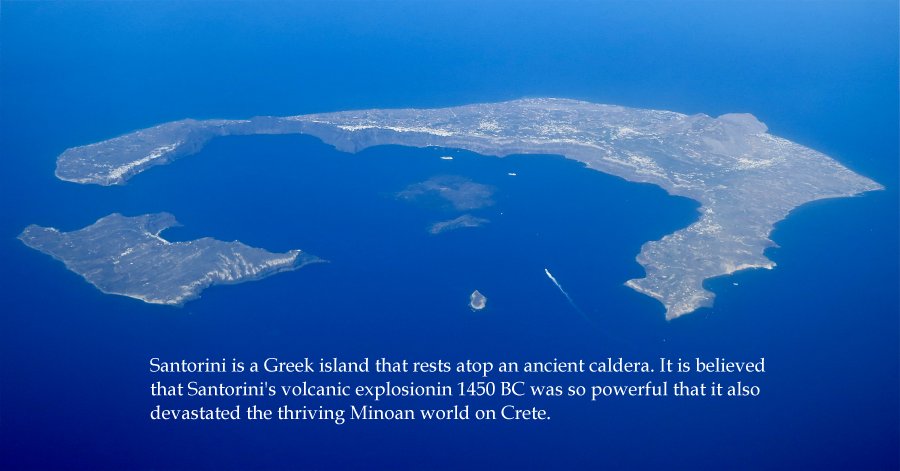Akrotiri Of Thera: Sophisticated City In The Greek Cyclades Devastated By Volcanic Eruption
A. Sutherland - AncientPages.com - Akrotiri is situated in the south of the main island of Thera, also known as Santorini, which lies in the Aegean Sea, approximately 100 km (62 miles) north of Crete.
Akrotiri was one of the most important prehistoric settlements in the region of the Aegean.
The first habitation at the site dates back to at least the 4th Millenium BC and during the Early Bronze Age (3rd Millenium BC), a large settlement was founded and during 2,000 BC – 1700 BC it was additionally extended and eventually became one of the most important urban centers and ports of the Aegean, with strong connections leading to the Minoan civilization.
Around 1500 BC, Akrotiri (sometimes called ‘Minoan Pompeii’) was abandoned because of an earthquake and totally destroyed by volcanic debris; the city has lain hidden undetected for several centuries. It is not yet known the exact date of the earthquake and subsequent volcanic eruption, but it seems clear that Akrotiri was abandoned before the end of Minoan civilization.
Usually, when a disaster occurs, the surviving people want to rebuild their place of living on the same site as soon as possible and if it is possible.
On the island of Santorini, people constructed modern buildings on or near those destroyed in earthquakes. Beneath the modern town, there are still seen volcanic deposits that remind people of the destruction and burial of the Bronze Age thriving settlement of Akrotiri.
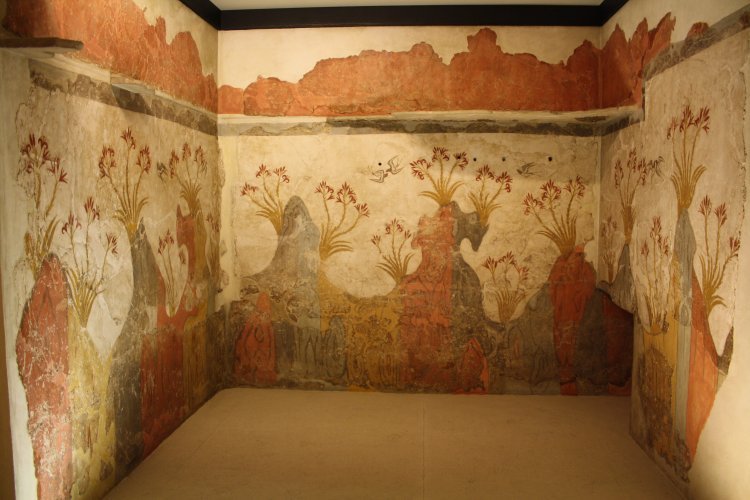
The Lilies Fresco from Akrotiri on the Aegean island of Thera, modern-day Santorini. Image credit: National Archaeological Museum, Athens via ancient.eu
The first chances to find the remains of buildings were in the late 19th century. Akrotiri (or more exactly a modern village situated on a hill nearby) was only found by chance. The name of the site in antiquity is unknown.
Archaeologists have confirmed that preservation of buildings and various artifacts at Akrotiri, on Santorini, is very good, with all beautiful frescoes surviving in some rooms and numerous pieces of pottery as they were abandoned by inhabitants.
Excavations revealed the sophisticated drainage system, buildings with several floors, the splendid wall-paintings, furniture, and pottery, which show that Akrotiri was prosperous and highly advanced. It had trade contacts with Crete and many other neighboring countries such as Cyprus, Syria, Egypt and the Greek Mainland, which was confirmed by a variety of imported objects unearthed in the buildings.
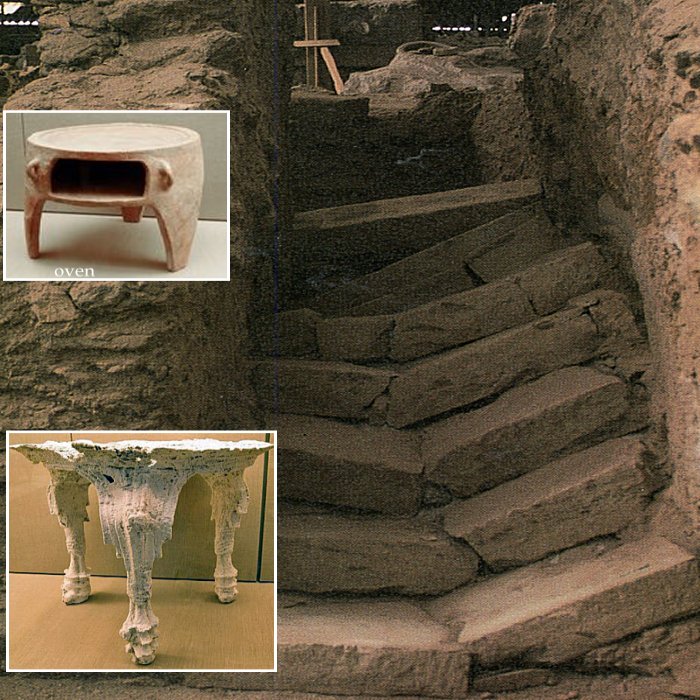
Excavations revealed the sophisticated drainage system, buildings with several floors, the splendid wall-paintings, furniture, and pottery, which show that Akrotiri was prosperous and highly advanced.
Unlike Pompeii, no human remains were discovered at Akrotiri - the residents clearly had been warned of the town's destruction.
The disaster of Akrotiri has been often related to the legendary Atlantis, mentioned in Plato's dialogues Timaeus and Critias. It has been suggested that Santorini may have been the location of ancient Atlantis and the idea was popular in the 1960s when excavation began on the small town of Akrotiri.
After removing the volcanic ash, archaeologists saw pictures of ancient people fishing and navigating by boat along with scenery in the background depicting the island's vegetation and wildlife, exactly as Plato described in his ancient works.
Could it be that these ancient frescos are the sole remaining evidence of ancient Atlantis?
Even if it is believed that Santorini is the location of Atlantis, there are still several discrepancies between this island and the one described by Plato.
For instance, Plato described that Atlantis existed 9,000 years before his lifetime and that Atlantis - as it was frequently mentioned in diverse ancient texts - was a huge landmass compared to Asia Minor and Libya combined. Santorini is not of this size.
There are also several other problems with this particular location of Atlantis.
Anyway, whether Atlantis was a real civilization, or if it was a myth, is a matter of one of the greatest debates. There were several of Plato’s disciples who followed his ideas, principles, and claims along with that of the legendary Atlantis.
Written by – A. Sutherland AncientPages.com Staff Writer
Copyright © AncientPages.com All rights reserved. This material may not be published, broadcast, rewritten or redistributed in whole or part without the express written permission of AncientPages.com
More From Ancient Pages
-
 Oldest Door Lock Comes From Ancient Egypt
Ancient History Facts | Jun 27, 2018
Oldest Door Lock Comes From Ancient Egypt
Ancient History Facts | Jun 27, 2018 -
 Top 5 Terrors Of The World’s Seas, Rivers And Lakes
Featured Stories | Mar 27, 2021
Top 5 Terrors Of The World’s Seas, Rivers And Lakes
Featured Stories | Mar 27, 2021 -
 Ancient Roman Laws Give Us A Window Into A World Of Abuse
Featured Stories | May 24, 2022
Ancient Roman Laws Give Us A Window Into A World Of Abuse
Featured Stories | May 24, 2022 -
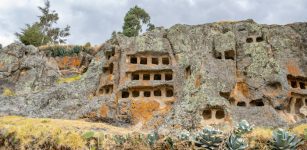 Fascinating Artificial Caves Of Ventanillas de Otuzco And Its Secret Passageways – Pre-Inca Necropolis Of The Cajamarca Culture
Featured Stories | Feb 5, 2022
Fascinating Artificial Caves Of Ventanillas de Otuzco And Its Secret Passageways – Pre-Inca Necropolis Of The Cajamarca Culture
Featured Stories | Feb 5, 2022 -
 When Giants Ruled North America – Encounters With Mysterious Races Of Giants – Part 1
Civilizations | Nov 20, 2018
When Giants Ruled North America – Encounters With Mysterious Races Of Giants – Part 1
Civilizations | Nov 20, 2018 -
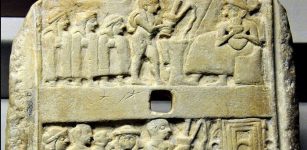 Ur – One Of The Largest And Most Important Cities Of Ancient Mesopotamia
Featured Stories | Jul 28, 2021
Ur – One Of The Largest And Most Important Cities Of Ancient Mesopotamia
Featured Stories | Jul 28, 2021 -
 Is This The World’s Oldest Joke?
Featured Stories | Feb 21, 2014
Is This The World’s Oldest Joke?
Featured Stories | Feb 21, 2014 -
 Ancient Mysteries Of West Virginia: Did Ancient Celts Visit North America Where They Left An Ogham Inscribed Bone Needle With Christian Symbols?
Artifacts | Mar 1, 2017
Ancient Mysteries Of West Virginia: Did Ancient Celts Visit North America Where They Left An Ogham Inscribed Bone Needle With Christian Symbols?
Artifacts | Mar 1, 2017 -
 Rhodogune Of Parthia Refused To Bath And Comb Her Hair Until She Subdued The Rebels
Featured Stories | Oct 7, 2019
Rhodogune Of Parthia Refused To Bath And Comb Her Hair Until She Subdued The Rebels
Featured Stories | Oct 7, 2019 -
 Pamola: Mighty Thunderbird In Myths Of Penobscot People Of Maine
Featured Stories | Apr 25, 2019
Pamola: Mighty Thunderbird In Myths Of Penobscot People Of Maine
Featured Stories | Apr 25, 2019 -
 Llanbadoc Discovery: Late Medieval Artifact And The Battle Of Usk
Artifacts | Oct 2, 2018
Llanbadoc Discovery: Late Medieval Artifact And The Battle Of Usk
Artifacts | Oct 2, 2018 -
 Preserve Elfdalian: Sweden’s Secret Forest Language From The Viking Era
Civilizations | May 21, 2015
Preserve Elfdalian: Sweden’s Secret Forest Language From The Viking Era
Civilizations | May 21, 2015 -
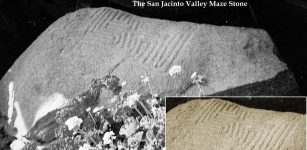 Baffling Prehistoric Maze Stones In Hemet And San Jacinta Valley, California
Ancient Symbols | Jun 24, 2016
Baffling Prehistoric Maze Stones In Hemet And San Jacinta Valley, California
Ancient Symbols | Jun 24, 2016 -
 Remarkable Underground City Of Nushabad: A Masterpiece Of Ancient Architecture
Ancient Technology | Nov 17, 2015
Remarkable Underground City Of Nushabad: A Masterpiece Of Ancient Architecture
Ancient Technology | Nov 17, 2015 -
 Norse God Hermod’s Meeting With The Finnish Magician Rostioff Who Revealed The Prophecy Of Vali
Featured Stories | Feb 13, 2023
Norse God Hermod’s Meeting With The Finnish Magician Rostioff Who Revealed The Prophecy Of Vali
Featured Stories | Feb 13, 2023 -
 Why Napoleon’s Invasion Of Russia Was A Fiasco
Ancient History Facts | Mar 31, 2017
Why Napoleon’s Invasion Of Russia Was A Fiasco
Ancient History Facts | Mar 31, 2017 -
 Great Pyramid of Cholula Is The Largest In The World Today
Ancient History Facts | Feb 9, 2016
Great Pyramid of Cholula Is The Largest In The World Today
Ancient History Facts | Feb 9, 2016 -
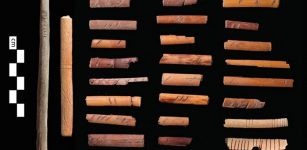 America’s First Casino Was Created By The Promontory Culture 700 Years Ago
Ancient History Facts | Apr 30, 2016
America’s First Casino Was Created By The Promontory Culture 700 Years Ago
Ancient History Facts | Apr 30, 2016 -
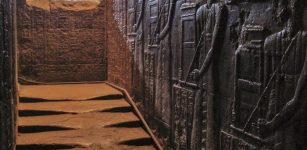 What Happened To The Staircase In The Temple Of The Goddess Hathor?
Civilizations | Mar 9, 2017
What Happened To The Staircase In The Temple Of The Goddess Hathor?
Civilizations | Mar 9, 2017 -
 Aillén Mac Midgna: Evil Goblin Who Terrorized Sacred Hill Of Tara
Celtic Mythology | Mar 28, 2023
Aillén Mac Midgna: Evil Goblin Who Terrorized Sacred Hill Of Tara
Celtic Mythology | Mar 28, 2023

